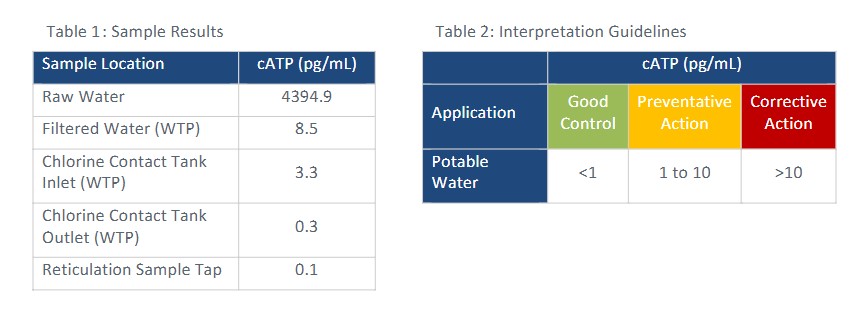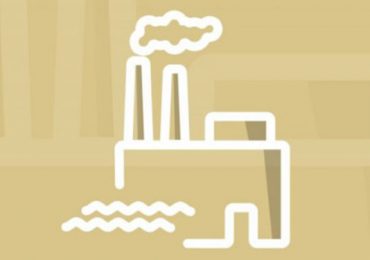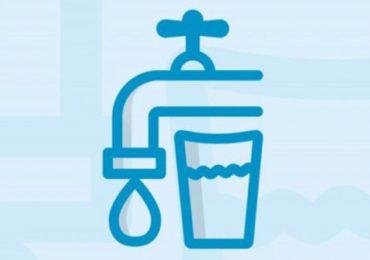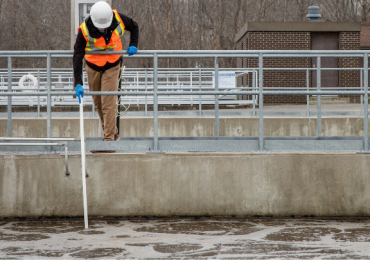What’s inside
A regional water authority in Australia was dealing with an algae bloom in their source water. They investigated the use of 2nd generation ATP testing to rapidly measure algae biovolume.
The proposed sampling plan consisted of weekly measurements at 152 sampling sites during the algae bloom. The anticipated cost for test kits would be approximately $30,000 AUD ($21,000 USD).
Economic analysis: The algae bloom cost an estimated $250M AUD ($175M USD), which included loss of water for drinking, recreation, agriculture, and fishing. Even a 1% reduction in the overall economic cost of an algae bloom would result in a >80x return-on-investment for implementing rapid ATP testing.
What are blue-green algae?
Blue-green algae are a natural part of most aquatic environments, but they tend to like calm, warm waters with some nutrients for growth. There are many species of blue-green algae, some produce taste and odour compounds, these are commonly earthy or musty odours and are not removed by normal water treatment processes.
Some species can also produce toxins with potential for serious health implications to all animals that come into contact with them, including humans. The three main types of toxin associated with blue–green algae which are found in Australia are:
- hepatotoxins, which damage liver cells;
- neurotoxins, which damage nerve cells; and
- cylindrospermopsin, which can damage the liver, kidneys, lungs, heart, stomach, adrenal glands, the vascular system, and the lymphatic system. With acute clinical symptoms being kidney and liver failure.
Even if blue-green algae are not producing these specific toxins, all blue-green algae have compounds in their cell structure that can cause allergic reactions in around 10 to 20% of the population.
Dangerous algae bio-volume levels in drinking water
In the summer of 2015-2016, a regional Victorian Water Authority was experiencing severe challenges from algae in the Murray River, their water source for 10 communities servicing a population of 15,000+.
A Red Alert was declared for 115 days to these communities. In accordance with regulatory requirements, Recreational Red Alerts are issued when the combined toxic blue-green algae biovolume reaches 4 mm3/L or when the total blue-green algae biovolume reaches 10 mm3/L.
However, due to the health risks these organisms pose ,the Australian Drinking Water Guidelines recommend that alerts for drinking water initiate at a biovolume of 0.6 mm3/L. Over the 5-month period, algae total bio-volume levels were observed well above the Recreational Red Alert trigger for warning and in one instance >75mm3/L. These conditions presented very big challenges to water authorities along the river in delivery of safe drinking water to their communities and customers.
Measuring algae total bio-volume levels with 2nd generation ATP®
In March 2016, the regional Victorian Water Authority sought assistance from LuminUltra Technologies to investigate the opportunity for 2nd Generation ATP measurement to help with rapid measurement of algae total bio-volume levels. Existing methods involved sending samples to an external laboratory for measurement and reporting. This process took 4 days on the express service to deliver the results. With consideration of the critical nature of the situation, this time for feedback proved additionally problematic for water treatment plants looking to produce high quality potable water to their customers.
Initial evaluation stage
LuminUltra’s test kits are based on the measurement of ATP, which is a direct and interference-free indicator of total living biomass. ATP is measured using the firefly luciferase assay, in which a sample containing ATP is introduced to a solution containing the enzyme Luciferase, which naturally occurs in the tails of fireflies, to produce light. The light is detected in a luminometer as relative Light Units (RLU).
A sanitary survey of 2nd Generation ATP Quench Gone Aqueous (QGA) tests was conducted from source to tap and in between of the microbial load. Below Table 1 shows results of this testing and Table 2 the LuminUltra Technologies interpretation guidelines for potable drinking water.
These results demonstrated the ability to collect quantitative measurements of the total microbial load and threat in each of the various points in the drinking water process from source to tap. It also verified the excellent performance of the treatment process and delivery of safe drinking water to this local community.
Based on the preliminary results of the initial investigation it was decided to conduct further testing of 2nd Generation ATP for potential correlation between lab results and ATP results. The initial testing was conducted with the QGA ATP test kit but for this next evaluation stage Differential Quench Gone Organic (dQGO-M) was utilized.
The dQGO-M method leverages the size fractionation and uses a larger-porosity (5μm) dQGO-M filter to capture large cells, such as blue-green algae, but allow other smaller bacteria to pass through. An additional dispersant reagent is also included to break up clumps of small cells that would otherwise be retained on the filter. In this modified protocol, the sample is pre-treated with the dispersant in order to break up microbiological flocs, and then this pre-treated sample is passed through the dQGO-M filter. The result is a measurement of Cellular ATP (cATP™) resulting from larger cells (e.g., fungi, algae, protozoa).
Samples were collected, and serial dilutions performed. These samples were then sent to the lab for results and split sampling testing was also performed with the LuminUltra dQGO-M test kit. Tests were performed and categorized in accordance with the dominant algae species. Results are shown in Figure 1.
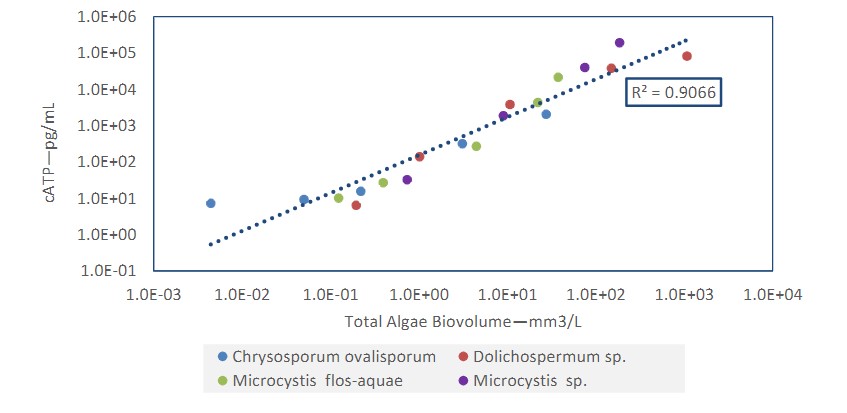
Key findings
A strong correlation is observed between total algae biovolume and 2nd Generation ATP dQGO-M results. Some variation in the correlation factors is also observed based on the dominant species. Further testing and data would be recommended to provide a concrete correlation. Users would be encouraged to perform their own tests to establish correlation on the above conclusions and their own site-specific environments.
Combined with the 2nd Generation QGA test kit, water treatment operators can assess microbial load and efficacy of each of the critical control points throughout their water treatment process and distribution network. Efficacy and subsequent troubleshooting of problems in the water treatment process can be identified rapidly to instigate rapid mitigation and confirmation.
LuminUltra’s 2nd Generation ATP solutions are portable and rapid allowing the water utility to utilize a single equipment set to cover all their sites and obtain meaningful results in minutes. The speed of response accompanied with the validation testing provides a tool for immediate response and optimization of the water treatment plant process to ensure delivery of safe drinking water to their communities and customers.
Economic analysis and conclusions
Harmful algae blooms can have a devastating economic impact. The 2016 Murray River algae bloom had an estimated loss of $250 million AUD ($175 million USD), which included loss of water for drinking, recreation, agriculture and fishing. Similar impacts have been estimated globally.
Preventing harmful algae blooms requires a multifaceted approach. The Murray Darling Basin Commission has a long-term management strategy that includes reduction in point source nutrients, repair and protect riparian zones and upstream reservoir management. Monitoring is an important consideration for any management strategy to understand when and where blooms are occurring and to assess the effectiveness of mitigation strategies. LuminUltra’s 2nd Generation ATP is a great option to include in a comprehensive monitoring strategy as it reduces the feedback loop between measurement and action from days to hours.
During the 2016 Murray River bloom, samples were taken from 152 sites on a weekly basis (>1500 samples). The cost of dQGO-M ATP tests for this monitoring plan is approximately $30,000 AUD ($21,000 USD). Traditional microscopy methods take approximately 4 days, so by using ATP, Red Alerts can be detected earlier, resulting in public health savings associated with illness reduction, and cleared earlier, allowing businesses to return to normalcy. Even a 1% reduction in the overall economic cost of an algae bloom would result in a >80x return-on-investment for implementing rapid ATP testing.





